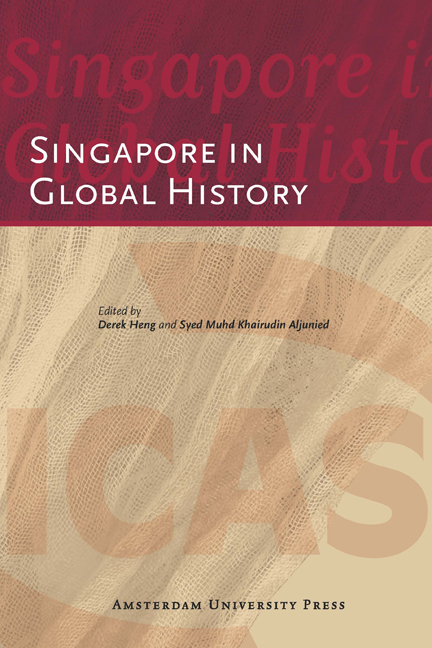Book contents
- Frontmatter
- Contents
- List of Tables and Illustrations
- Foreword
- 1 Globalising the History of Singapore
- 2 Situating Temasik within the Larger Regional Context: Maritime Asia and Malay State Formation in the Pre-Modern Era
- 3 The Singapore River/Port in a Global Context
- 4 ‘Walls of Illusion’: Information Generation in Colonial Singapore and the Reporting of the Mahdi-Rebellion in Sudan, 1887-1890
- 5 The Littoral and the Literary: Making Moral Communities in the Straits Settlements and the Gold Coast in the late Nineteenth and Early Twentieth Century
- 6 Social Discourse and Economic Functions: The Singapore Chinese in Japan’s Southward Expansion between 1914 and 1941
- 7 The Dynamics of Trans-Regional Business and National Politics: The Impact of Events in China on Fujian-Singapore Tea Trading Networks, 1920-1960
- 8 Rambutans in the Picture: Han Wai Toon and the Articulation of Space by the Overseas Chinese in Singapore
- 9 The Global Effects of an Ethnic Riot: Singapore, 1950-1954
- 10 The British Military Withdrawal from Singapore and the Anatomy of a Catalyst
- 11 Bringing the International and Transnational back in: Singapore, Decolonisation, and the Cold War
- 12 The Global and the Regional in Lee Kuan Yew’s Strategic Thought: The Early Cold War Years
- 13 A Brief History of the Hub: Navigating between ‘Global’ and ‘Asian’ in Singapore’s Knowledge Economy Discourse
- About the Contributors
- Bibliography
- Miscellaneous Endmatter
7 - The Dynamics of Trans-Regional Business and National Politics: The Impact of Events in China on Fujian-Singapore Tea Trading Networks, 1920-1960
Published online by Cambridge University Press: 02 February 2021
- Frontmatter
- Contents
- List of Tables and Illustrations
- Foreword
- 1 Globalising the History of Singapore
- 2 Situating Temasik within the Larger Regional Context: Maritime Asia and Malay State Formation in the Pre-Modern Era
- 3 The Singapore River/Port in a Global Context
- 4 ‘Walls of Illusion’: Information Generation in Colonial Singapore and the Reporting of the Mahdi-Rebellion in Sudan, 1887-1890
- 5 The Littoral and the Literary: Making Moral Communities in the Straits Settlements and the Gold Coast in the late Nineteenth and Early Twentieth Century
- 6 Social Discourse and Economic Functions: The Singapore Chinese in Japan’s Southward Expansion between 1914 and 1941
- 7 The Dynamics of Trans-Regional Business and National Politics: The Impact of Events in China on Fujian-Singapore Tea Trading Networks, 1920-1960
- 8 Rambutans in the Picture: Han Wai Toon and the Articulation of Space by the Overseas Chinese in Singapore
- 9 The Global Effects of an Ethnic Riot: Singapore, 1950-1954
- 10 The British Military Withdrawal from Singapore and the Anatomy of a Catalyst
- 11 Bringing the International and Transnational back in: Singapore, Decolonisation, and the Cold War
- 12 The Global and the Regional in Lee Kuan Yew’s Strategic Thought: The Early Cold War Years
- 13 A Brief History of the Hub: Navigating between ‘Global’ and ‘Asian’ in Singapore’s Knowledge Economy Discourse
- About the Contributors
- Bibliography
- Miscellaneous Endmatter
Summary
Introduction
This chapter examines the business network of the Chinese tea merchants in Singapore and the impact of events in China on it. Large numbers of overseas Chinese who had migrated from Fujian to Singapore were familiar with Fujian tea and continued to consume it. This consumption pattern led to the merchants in Fujian opening new firms in Singapore to trade in Fujian tea, especially semi-fermented wulong varieties such as Anxi tieguanyin (安溪铁观音) and Wuyi shuixian (武夷水仙). These merchants arrived in Singapore either to start branches of their families’ tea businesses from Fujian or to establish new companies to import, reprocess, and re-export teas.
Before 1949, the National Government of the Kuomintang (KMT) played a negligible role in promoting Fujian tea overseas. It was left to the Chinese merchants in Fujian to seek new markets in Southeast Asia as Chinese tea exports to Western Europe, North America and Japan declined (Buck 1997: 9). Southeast Asia was the last place they looked, but their work was made easier by the Chinese community, which was eager to consume home-grown tea. However, cracks in the networks began to appear from the 1930s onwards. Political events in China after 1949 eventually brought these networks to an abrupt end in 1960. Although the Communist government had tried to promote Fujian tea, it was determined that trade should be conducted on the political leadership's own terms.
Expanding the business network
Since 1819, Chinese merchants in Singapore had imported tea from China as part of a British colony involved with the entrepot trade. However, they were usually classified as ‘general merchants’ because tea was only one among many commodities imported. This situation changed in the early 20th century with the arrival of new merchants from Anxi County (安溪县), a tea-growing region in Fujian province, who specialised in the sale of tea in Singapore. The first Anxi merchant to arrive was Koh Beng Jin (高铭壬), who started Koh Beng Huat Tea Merchant (高铭发茶庄) in 1905 (the Singapore Ann Kway Association 1974: 357).
- Type
- Chapter
- Information
- Singapore in Global History , pp. 135 - 150Publisher: Amsterdam University PressPrint publication year: 2012



